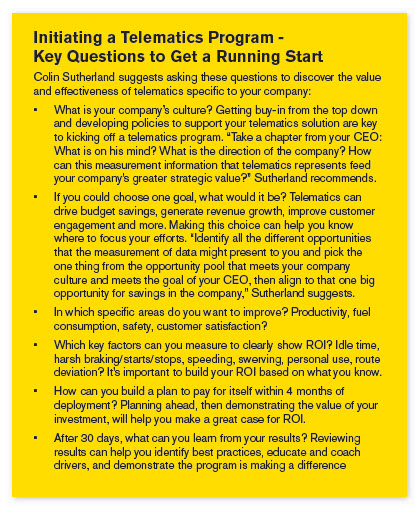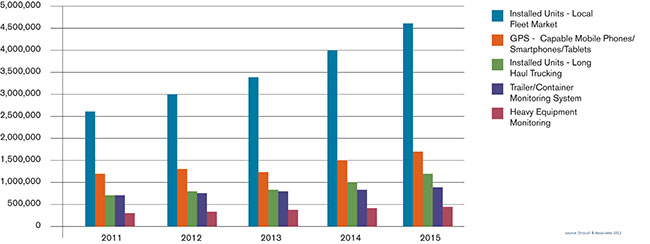Beyond The Basics: Fleet Management Solutions At The Next Level
Traditionally, telematics devices have been used to track the location of vehicles. But increasingly fleet solutions provide analytics that offer fleet managers a much broader and more detailed view of activity in the field. As a result, fleet managers are realizing the benefits of incorporating these analytics into their day-to-day operations.
When telematics are combined with powerful analytics, near real-time management alerts and insightful reporting they allow businesses with fleets to measure how well they are managing their business today, set strategies and goals for improvement and track improvement against those goals. Sprint ® Connected Fleet solutions empower businesses to better manage their mobile resources; consequently, companies realize significant increases in operating efficiencies and productivity and solve real business problems.
For these reasons and more, connected fleet solutions are rapidly growing in popularity and are becoming a go-to tool for businesses across the country.
LEVERAGING TELEMATICS FOR MOBILE RESOURCE MANAGEMENT: A GROWING MARKET
Mobile Resource Management (MRM) is a broader category of solutions that leverages GPSenabled telematics to better manage mobile resources such as workers, vehicles and other assets. Because of the visibility it offers and the results it yields, mobile resource management is a booming market.
According to a 2012 study by C.J. Driscoll & Associates, more than 300,000 companies are leveraging MRM systems and services — and more than five million MRM units are in service. This includes units installed in fleet vehicles, GPScapable mobile devices/tablets, units installed on long-haul trucks, trailer/container monitoring systems and heavy equipment monitoring.
This market continues to grow. Today in the local fleet market more than 20% of approximately 14 million vehicles are leveraging the power of telematics. But as these solutions become more and more affordable and awareness of the benefits becomes more widespread, it is estimated that by 2015 telematics will become a staple for good fleet management, with nearly one-third of local fleet vehicles utilizing its capabilities.
Several factors have contributed to the rapid growth in connected fleet management solutions:
- Low hardware costs
- Low cellular data costs
- Expanded Features like navigation, OBD-II driver score cards, and fuel caed integration.
- Significant ROI
“The return on investment for local fleet operators is clear and compelling. That’s the principal reason why the market annual growth rate is up in the 15-20% range and it’s been there the last two to three years,” says Clem Driscoll, C.J. Driscoll & Associates. “The market has reached critical mass, meaning many fleet operators are feeling the need to deploy a solution in order to remain competitive. They know competitors that are using a telematics solution and are benefiting from it.”
5 million+ MRM Units in Service
THE IMPACTS OF TELEMATICS AND MRM
Fleet management solutions today offer a degree of sophistication that gives fleet managers a higher level of visibility into fleet location and activity than in years past. Now, fleet solutions even provide detailed analysis on the impact of driver behavior and vehicle activity on operating costs and fuel usage.
For example, using telematics with easy-to-use user interfaces, fleet managers can see in near real time the location of a vehicle as well as time spent idling, the current speed, the temperature of the cargo and more. When analytics are applied to this data, fleet managers gain insight on the effect speed and idling have on fuel consumption.
A fleet manager can then educate his drivers to understand the impacts of their behavior and work to modify driving habits, resulting in overall fuel savings for the company.
“For many years in the GPS tracking industry, it was mostly about user interface presenting dots on a map for fleets so we could see the efficiency of employees in the field.
It really was the basics, and the industry has significantly evolved,” states Colin Sutherland, Vice President, Geotab. “The evolution of telematics has gone way beyond the user interface and making things look nice for fleet customers. It’s primarily now about the data and what we’re recording behind the scenes.
That’s really where the value is. Having these additional layers of data helps fleets solve real business problems. Now, in addition to location, telematics devices often record data on:
- Fuel levels – Allowing fleets to track fuel levels and understand fuel consumption
- Mileage – Making it easier to schedule maintenance based on the actual miles driven
- Diagnostics – Identifying problems early on to help prioritize maintenance, prevent more costly repairs, prevent roadside breakdowns and improve vehicle safety
- Driver behavior – Helping provide instant feedback to drivers, improve safe driving habits, reduce aggressive driving and achieve better fuel economy
Many organizations turn to MRM solutions not only because of the potential savings and productivity gains but also because of how quickly these improvements can be achieved and begin generating a return on investment. MRM solutions can positively impact fleet operations in a number of ways:
- Driver productivity – Knowing the location of drivers provides fleet managers insight into whether they adhere to schedules, follow assigned routes and drive vehicles for personal use
- Efficient dispatching – Vehicle location makes it easy to find the driver closest to the call which gets the job done faster
- Lower fuel consumption – Knowing the average MPG for each vehicle makes it easy to identify areas of improvement such as speeding, sudden stops and quick acceleration which can impact fuel economy
- Driver habits – Driver scorecards help fleet managers coach drivers on eliminating unsafe driving behaviors like speeding, fast cornering and hard braking or acceleration; reducing these behaviors leads to improved fuel economy
- Messaging and dispatching – By integrating GPS with Garmin PNDs or other devices, fleets can benefit from text messaging, dispatching and navigation
- Vehicle condition – Maintenance reminders and diagnostics can improve the efficiency, safety and overall condition of vehicles
“By connecting GPS and telematics industry information you go from figuring out how to resolve a problem today like, ‘Where are my vehicles?’ to resolving a business problem like, “How do I reduce the number of spare vehicles I have in my fleet to lower than where it is right now,” Sutherland says. “Most companies in the fleet world we work with have greater than 9-10% of spare vehicles.
And after using telematics, they drove that number down to below 2%, which is remarkable. One of our fleet customers has over 50,000 vehicles and operates at less than 2% spare vehicles on a daily basis.”
Even though telematics devices can capture volumes upon volumes of data, it doesn’t mean more work for managers. Instead, powerful analytics boiled down into simple graphs and reports can summarize the data in useful ways – so it’s easy to measure performance in a wide variety of areas and take action as needed.
THE ROI OF CONNECTED FLEETS
With data at your fingertips, connected fleet solutions use telematics technology to accurately measure a variety of activities, allowing organizations to develop policies that aim to improve key metrics and then enforce those policies to make meaningful change. By measuring performance more accurately and in the context of time and location organizations can more readily identify and realize areas for operational savings. These efforts inevitably lead to a stronger bottom line.
“Telematics really is big data. It’s a collection of data in a host of environments. That data can be attached to multiple stakeholders in your company and software outside of your company, like scheduling and dispatch applications and fleet maintenance and fuel card providers,” Sutherland says. “Telematics is no longer dots on a map. Telematics today is a collection of data and is making data accessible for strategic business purposes.”
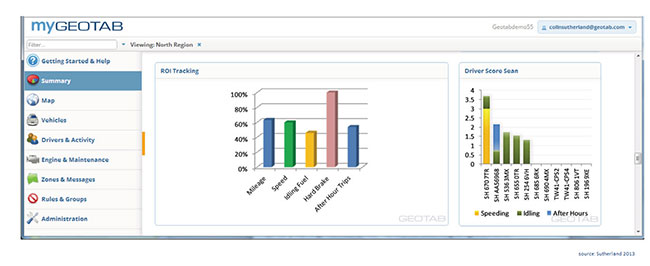 For instance, if an organization has a goal to reduce fuel expenditures, monitoring aggressive driving can help achieve this goal. Steve Cary, the Vice President of Feeney Wireless, says research shows vehicles like panel trucks and step vans will have a fuel penalty of 30-40% for aggressive driving in urban freeway environments. “What this means is if you can control aggressive driving, you can reduce fuel expenditures very rapidly, and at the magnitude of about 10% is what we’ve seen with our customers,” he says. Because driving behavior directly affects fuel economy, tracking these behaviors can help achieve the goal of reducing the fuel budget. By collecting data on aggressive driving behaviors, the fleet manager will know when and where aggressive driving happens in near real time – and then give instant feedback on how to improve these behaviors.
For instance, if an organization has a goal to reduce fuel expenditures, monitoring aggressive driving can help achieve this goal. Steve Cary, the Vice President of Feeney Wireless, says research shows vehicles like panel trucks and step vans will have a fuel penalty of 30-40% for aggressive driving in urban freeway environments. “What this means is if you can control aggressive driving, you can reduce fuel expenditures very rapidly, and at the magnitude of about 10% is what we’ve seen with our customers,” he says. Because driving behavior directly affects fuel economy, tracking these behaviors can help achieve the goal of reducing the fuel budget. By collecting data on aggressive driving behaviors, the fleet manager will know when and where aggressive driving happens in near real time – and then give instant feedback on how to improve these behaviors.
If correcting this behavior yields even a 10% fuel savings, the dollars add up quickly. For example, if a fleet of 30 vehicles that drive roughly 100 miles a day were to increase their mpg by 10%, and gas costs $4 per gallon, that yields a savings of $45,000 per year!
“It’s easy to calculate the savings,” Cary says. “That’s roughly $1,500 saved per vehicle, per year, just on fuel alone — let alone you get all the other benefits the technology can provide, such as knowing where your vehicle is at and having near real-time communications with the driver and the vehicle.
” With technology to accurately measure actual activity, organizations can communicate expectations, monitor behavior and take action – all leading to measurable savings. When compared with the costs to implement the connected fleet solutions, most companies see savings far outweigh the costs, providing a strong ROI and typically a short horizon pay back period.
BEYOND THE BASICS: CONNECTED FLEET TECHNOLOGY
Connected fleet solutions can do more than just measure and report performance data in near realtime. Using the wireless vehicle connection that transmits the data, solutions can actually turn the vehicle into a mobile hotspot, providing a Wi- Fi connection within the vehicle. This Wi-Fi connection can then be used to send and receive missioncritical information, provide access to resources, submit paperwork and more — all in near real-time and all while workers are mobile.
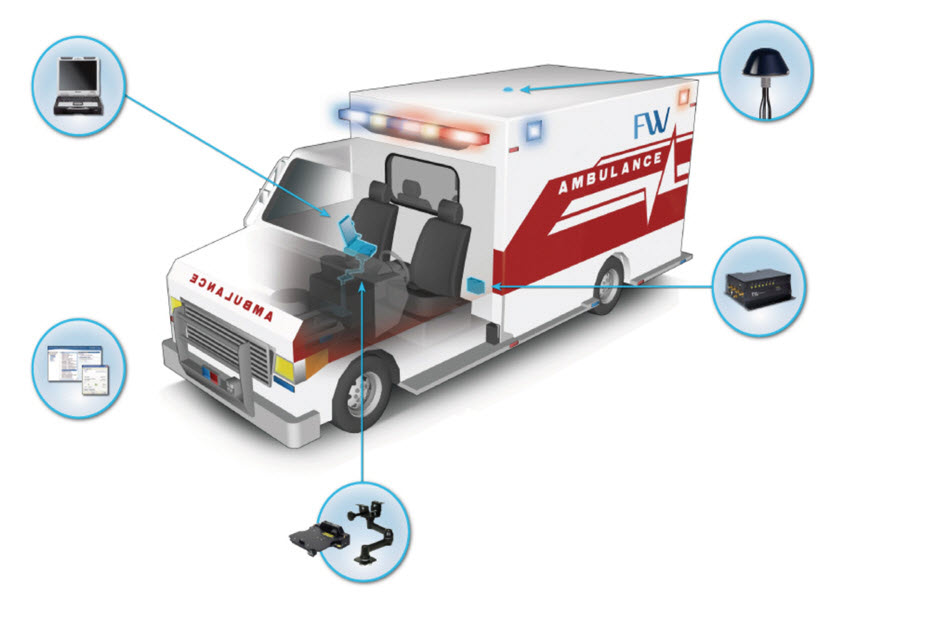 For example, by installing a broadband connection to the vehicle and a Wi-Fi access point that provided a network bubble in and around the vehicle, one company turned their ambulances into mobile hotspots. The company then set up a sophisticated mobile center that integrated missioncritical applications such as a computer-aided dispatch system and an embedded patient care record system so that emergency responders were dispatched quickly and had access to patient records when en route.
For example, by installing a broadband connection to the vehicle and a Wi-Fi access point that provided a network bubble in and around the vehicle, one company turned their ambulances into mobile hotspots. The company then set up a sophisticated mobile center that integrated missioncritical applications such as a computer-aided dispatch system and an embedded patient care record system so that emergency responders were dispatched quickly and had access to patient records when en route.
In addition, with this connected technology, they were able to take paper-based forms from the hospital and scan them in near real-time, eliminating data entry into paper-based forms at the end of their shift.
Quicker dispatch and en-route access to patient information proved to be lifesaving in manycases. On top of that, the ability to complete paperwork in near real time resulted in an unexpected cost savings: workers eliminated a half hour of overtime at the end of each day that was normally spent on data entry. The result was two immediate forms of ROI. 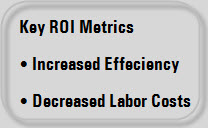 For one, the hospital had the ability to bill insurance companies in minutes, rather than hours or days. And second, eliminating overtime shifts reduced overall labor costs. For just one technician, the hospital saved $55 per week, or roughly $2,500 per person each year.
For one, the hospital had the ability to bill insurance companies in minutes, rather than hours or days. And second, eliminating overtime shifts reduced overall labor costs. For just one technician, the hospital saved $55 per week, or roughly $2,500 per person each year.
“They found that by creating a workspace or an office-like environment in the vehicle, it was a way to create meaningful ROI. Now they can do real-time forms processing throughout the day and not only do they reduce the labor per day, their ability to bill the insurance carrier has reduced from hours, if not days, to minutes,” Cary says. “Those two forms of ROI had a huge impact.”
CONNECTING MORE THAN THE VEHICLE: SERVICE CHAIN MANAGEMENT
Fleet management is one area of the company that benefits from adding connectivity for monitoring in ear real-time. But that’s not the only area of the organization that can benefit. Connecting vehicles, equipment, inventory and people across an organization can make it easier to manage the entire service chain more efficiently. For example, by connecting all of the elements of the service chain — from dispatch to delivery, customer call to technician response, breaking down to getting it fixed — adding connectivity helps organizations monitor and react faster so that deliveries are timely and more efficient, customers are happier and machines are humming longer.
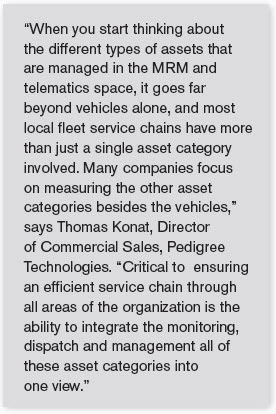 For instance, hardware installed on vehicles and equipment can alert staff when a matter needs attention – like when repairs are required or fluids need replenished. Armed with this knowledge, staff can then act in a timely manner, likely preventing problems down the road. Likewise if a technician is sent into the field to fix the problem, he or she can know which tools are required ahead of time – and can see the maintenance and repair history of the vehicle, all before arriving to do the job. Or, if a customer needs a delivery right away, dispatch is able to see which driver is closest to the job – and even whether they have the proper inventory to make the delivery.
For instance, hardware installed on vehicles and equipment can alert staff when a matter needs attention – like when repairs are required or fluids need replenished. Armed with this knowledge, staff can then act in a timely manner, likely preventing problems down the road. Likewise if a technician is sent into the field to fix the problem, he or she can know which tools are required ahead of time – and can see the maintenance and repair history of the vehicle, all before arriving to do the job. Or, if a customer needs a delivery right away, dispatch is able to see which driver is closest to the job – and even whether they have the proper inventory to make the delivery.
Once the delivery is dropped off, mobile apps enable the driver to submit billing information immediately, reducing paperwork and improving accounting accuracy and efficiency. “We’re taking traditional telematics technologies to do untraditional things, like take care of a machine or replenish a fuel tank at a convenience store, replenish a fuel tank at a construction site, get an oil change scheduled for a piece of heavy machinery that’s at an oil patch somewhere – lots of different things that can drive your service chain,” Konat says. “Machines can now start to raise their hand, can start to alert us when there is an issue that needs to be fixed. These things are becoming more prevalent with the evolution of telematics and machine-to-machine technologies that are becoming more standard, more affordable and certainly more adaptable to the processes and culture of companies who are trying to differentiate themselves.”
By leveraging connected solutions, organizations can integrate, measure and monitor from end-to-end. Where telematics were once used to manage the vehicle alone, a connected enterprise automates the service workflow, integrating and coordinating operations over time. This coordinated effort, orchestrated by both people and machines, ultimately improves efficiencies in service fulfillment, logistics, workflow, dispatch and more. Service chain management in turn reduces the time it takes to recognize a problem, dispatch service and resolve the problem – in total, reducing the total resolution time and resulting in happier customers at the end of the day.
No matter which assets your organization relies on or what strategic goals you wish to accomplish, leveraging telematics, connecting multiple mobile devices and integrating data connected throughout the service chain can streamline operations, improve the bottom line, and offer significant advantages over the competition.
SPRINT® CONNECTED FLEET
The benefits are clear: connecting vehicles and other assets to let managers know what is happening and react in near real time results in measurable savings and efficiencies. Time and again, implementing these solutions has resulted in positive returns on investment and, often, short payback periods.
Sprint offers a comprehensive portfolio of connected fleet solutions and support services that can help organizations of all sizes — regardless of mission — to realize significant savings from telematics and data analytics. As a leader in location-based technology with more than 12 years of experience in M2M and fleet management solutions, Sprint offers consultancy of design and engineering expertise along with a commitment to an exceptional customer experience.
Dedicated teams work with organizations through the design, set up, installation and ongoing use of their solutions, ensuring the solution fitted for each organization is addressing the short-term needs and long-term.
